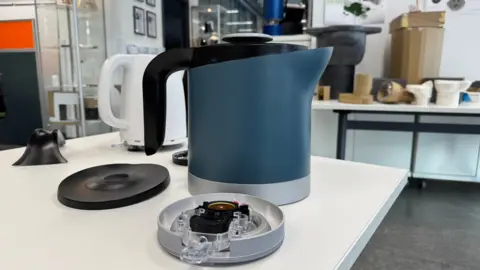 BBC
BBCA university graduate from Leicester has designed a kettle he says can be fixed by anyone with a screwdriver.
Gabriel Kay, 22, wants to help tackle what has been called the UK’s “e-waste tsunami”.
Various parts of the prototype kettle can be replaced if the electrics fail or if the owner wants a new style or colour.
According to comparison site USwitch, the UK discards more electrical goods per head of population than any other country except Norway.

Unlike typical kitchen products which are sealed units, Mr Kay’s award-winning Osiris kettle is designed to come apart by removing two screws in the base.
The electrical control unit can then be pulled out and the jug sleeve replaced if it is damaged or the owner wants a different look.
He said: “It’s a repairable kettle that’s based at looking at the waste crisis and how we can aim to mitigate our effect on it. I’ve tried to make it as simple as possible.”
Mr Kay, who attends De Montfort University (DMU), said he chose a kettle because it was so familiar, yet most people did not realise the environmental impact of swapping it for a newer model.
He believes designers bear some responsibility for the products they put out into the world which may encourage people to consume more.
“It’s drilled into us as designers.” he said. “The environment is the biggest issue. It’s everybody’s future. It’s about twisting that negative into a positive. How can we use that to benefit the world?”
Mr Kay was awarded a first-class BA in product design and is now looking for more opportunities to use his skills.

Mr Kay’s tutor, senior lecturer Alan Crummey, said students on the DMU design course were very aware of the issues around sustainability.
But he said it was not straightforward to teach them practical steps to produce greener products.
He argues that designers and manufacturers need to reverse their thinking to make it easier to reuse components and materials.
“Design for disassembly is not, oddly, just the reverse of design for assembly,” said Mr Crummey.
Up to now most products are designed to be assembled quickly and cheaply to keep prices down for consumers.
“That gave us a lot of benefits but it also gave us this unforeseen situation with e-waste,” he says.
“The object is to flip some of that thinking but without losing the gains we had in terms of manufacturing.”
Meanwhile, he believes the shift to sustainability should not be left to consumer choice.
“It’s not about making green products, it’s about all products being green,” he says.
“That’s about a transition over time. The problem is we don’t have that much time.”
E-waste growing faster than ever
 Recycle Your Electricals and SWEEEP Kuusakoski
Recycle Your Electricals and SWEEEP KuusakoskiResearch from the United Nations Institute for Training and Research suggests that global e-waste is growing five times faster than documented efforts to recycle it.
In recent years, one of the biggest contributors has been disposable vapes which are due to be banned in the UK by next summer.
But our appetite for the latest gadget is also a huge contributor to e-waste and leaves many of us with what Material Focus calls the “drawer of doom”.
On average, each UK household hoards at least 20 unused electronic appliances, and collectively we have enough unused cables lying around to circle the world five times.
That means we are missing out on some valuable materials, such as copper and rare earths that are crucial to renewable technologies.
Recycling our small electricals is the first step. In the East Midlands, some councils now offer doorstep collection.
Others are offering trial drop–off points for unused technology which can be wiped and used to help people who are unable to access the internet.
But to make a real difference to our environment, we should be buying fewer electronic items and reusing the ones we have.
The mantra of “reduce, reuse, recycle” is now taught at most primary schools.
Judging by the e-waste statistics, it is a lesson many of us adults have yet to learn.

